 |
|
Shorter diabetes duration and thicker central subfield thickness may put patients at greater risk for developing DME in the fellow eye. Photo: Erik Hanson, MD. Click image to enlarge. |
Center-involved diabetic macular edema (DME) causes many patients with diabetic retinopathy to lose vision; as such, it’s important to catch the disease early and initiate timely treatment to reduce the risk of DME-related blindness.
According to a recently published post-hoc analysis of the VISTA and VIVID studies evaluating intravitreal aflibercept injection safety and efficacy, developing DME in the fellow is fairly common. The researchers reported that 44.9%, 44.2% and 42.9% of fellow eyes developed DME during a 100-week period following two intravitreal aflibercept injection groups (2mg q4w and 2mg q8w) and a laser photocoagulation group, respectively. In the combined treatment groups, mean time to DME development was about six months.
The fact that nearly half of study participants developed DME in the fellow eye is concerning, considering that many patients with one eye affected by DME rely heavily on their other eye for performing daily activities, the researchers pointed out. Patients with a shorter diabetes duration (HR: 1.16 per 10-year decrease) and thicker baseline central subfield thickness (HR: 1.01 per 10µm increase) were more likely to develop fellow-eye DME.
“Patients with thicker central subfield thickness may have more severe disease and are therefore at higher risk of developing DME in the fellow eye,” the researchers suggested in their paper. “The correlation between macular thickening and diabetic retinopathy severity, as well as the increased prevalence of DME in patients with more severe disease, has been well described and may support the potential rationale for our findings.”
Higher DRSS score and lower BCVA in the study eye as well as not receiving insulin were also linked to increased risk. Risk increased with each additional risk factor.
“These findings suggest that patients with at least one of these risk factors may benefit from more aggressive monitoring for DME development in the fellow eye,” the researchers wrote in their paper.
Dhoot DS, Moini H, Reed K, et al. Incidence of new diabetic macular edema in fellow eyes of patients in the VISTA and VIVID studies. Retina. October 17, 2022. [Epub ahead of print]. |


